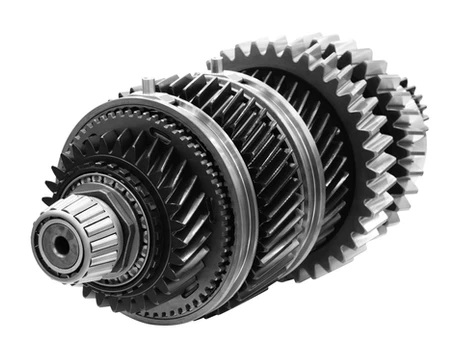
The first commercially produced automotive transmissions were simple manual gearboxes. In the early days of motoring, cars were not affordable for everyone. Roads weren’t suited for the high speeds that we drive at today, so cars simply weren’t built to travel that fast. A standard gearbox had one reverse gear and 2 forward gears.
Like with modern manual gearboxes, the driver used a clutch pedal and shift lever to select gears. The clutch pedal disengages the motor input from the transmission, so that the gears are not forcibly turning as they mesh together. The shift lever, naturally, aligns the appropriate gear with the motor input.
The perceived problem with these transmissions, though, was that it was inconvenient to have to shift manually. Apparently, it also required a fair amount of force. This made shifting a distraction from the road, and made it unappealing for women to drive. But roads were growing across the country, and autos were becoming more affordable, so manufacturers wanted to mass produce cars that had greater appeal to the general populace --- particularly women.
In 1940, Oldsmobile rolled out the Hydra-matic, the first hydraulic automatic transmission. To workaround the need for a clutch plate, they had developed a fluid coupling. The connection between the motor input and the transmission was now liquid, rather than solid: an input turbine churned hydraulic fluid into an output turbine that operated the transmission. No direct contact of moving parts was needed any longer. The one drawback to this system is that transmitting power through a hydraulic medium results in a loss of power.
Shifting was also made easier with the integration of planetary gear assemblies. These systems keep all gears turning at the same time, so that all gears are in sync. Even better, different outputs can be achieved through various combinations of different gear ratios. Below is a 13-minute video explaining how it works.
Because multiple outputs can be achieved from one gear assembly, they offer more gear ratios from amore compact transmission. And more gear ratios was just what was needed to achieve the high speeds of modern vehicles.
The automatic transmission made its final leap to the finely tuned hydraulic machine that it is today in1947 when Buick introduced their Dynaflow transmission. This was the first commercially produced transmission that implemented a torque converter. A torque converter is a fluid coupling that actually multiplies the torque incoming from the motor input.
This is highly useful because it allows smaller gears to produce more torque. Thus, a transmission can be geared with smaller gear ratios, which allows for optimal operation at higher speeds. The torque converter became common in commercially produced vehicles, when competitors like the Packard Ultramatic and the Chevrolet Powerglide emerged shortly after the Dynaflow.
Of course, the manual gearbox was present throughout this time period as well, and is still today. The hydraulic automatic is the most popular transmission in the US, but manual transmissions have their place in the hearts of enthusiasts.
Variations on the hydraulic automatic and the traditional gearbox have emerged since, as well.
The manual has advanced in the form of the high performance Direct Clutch Transmission, which addresses the biggest performance problems with manual transmissions --- they take time to shift (learn how DCT’s fix that problem here). The DCT made its way into a competitive racing model developed by Porsche in the1970’s. The VW Golf R32 was the first consumer car to implement it, in 2003. Bugatti, Nissan, Ferrari, Porsche and Mitsubishi have all followed suit in limited capacity.
Automatics now use sensors and electronics where they once relied on mechanics. These changes have allowed for advancements like the tiptronic transmission in modern sport and sport-economy cars. Its really not a different type of transmission; it just comes equipped with a few extra components that allow the driver to manually signal a gear shift in an automatic transmission. This option is becoming widely available.
Finally, there’s a third type of transmission that is, by definition, neither an automatic transmission or a manual. It doesn't require gear shifts at all, as it uses a belt and pulley system that can adjust gear ratios to keep the vehicle operating directly in the power band. Most major auto manufacturers have at least one or two models that implement a Constantly Variable Transmission.
To learn more about the pros and cons of different types of transmissions, see this post.
To learn what vehicles owners need to know about transmission maintenance, see our simplified overview on transmissions here
If you’re in the Des Moines, WA area and you need transmission maintenance or repairs (or any other type of service for your vehicle), you can call ABC Auto Repair at (206) 395-5300 or fill out a contact form here.